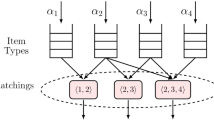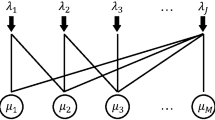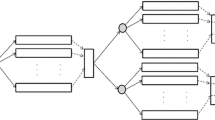Abstract
Motivated by growing applications in two-sided markets, we study a parallel matching queue with reneging. Demand and supply units arrive to the system and are matched in an FCFS manner according to a compatibility graph specified by an N-system. If they cannot be matched upon arrival, they queue and may abandon the system as time goes by. We derive explicit product forms of the steady-state distributions of this system by identifying a partial balance condition.





Similar content being viewed by others
References
Adan, I., Weiss, G.: Exact FCFS matching rates for two infinite multitype sequences. Operat. Res. 60(2), 475–489 (2012)
Adan, I., Weiss, G.: A skill based parallel service system under FCFS–ALIS–steady state, overloads, and abandonments. Stoch. Syst. 4(1), 250–299 (2014)
Adan, I., Foley, R.D., McDonald, D.R.: Exact asymptotics for the stationary distribution of a Markov chain: a production model. Queueing Syst. 62(4), 311–344 (2009)
Adan, I., Bušić, A., Mairesse, J., Weiss, G.: Reversibility and further properties of FCFS infinite bipartite matching. Math. Operat. Res. 43(2), 598–621 (2017)
Adan, I., Kleiner, I., Righter, R., Weiss, G.: FCFS parallel service systems and matching models. Perform. Eval. 127, 253–272 (2018)
Adan, I., Boon, M.A.A., Weiss, G.: Design heuristic for parallel many server systems. Euro. J. Operat. Res. 273(1), 259–277 (2019)
Afèche, P., Diamant, A., Milner, J.: Double-sided batch queues with abandonment: modeling crossing networks. Operat. Res. 62(5), 1179–1201 (2014)
Afèche, P., Caldentey, R., Gupta, V.: On the optimal design of a bipartite matching queueing system. Available at SSRN 3345302, (2019)
Boxma, O.J., David, I., Perry, D., Stadje, W.: A new look at organ transplantation models and double matching queues. Probab. Eng. Inform. Sci. 25(2), 135–155 (2011)
Caldentey, R.A., Kaplan, E.H.: A heavy traffic approximation for queues with restricted customer-server matchings. Working paper, (2007)
Fazel-Zarandi, M.M., Kaplan, E.H.: Approximating the first-come, first-served stochastic matching model with Ohm’s law. Operat. Res. 66(5), 1423–1432 (2018)
Gardner, K., Righter, R.: Product forms for FCFS queueing models with arbitrary server-job compatibilities: An overview. arXiv preprint arXiv:2006.05979 (2020)
Gardner, K., Zbarsky, S., Doroudi, S., Harchol-Balter, M., Hyytiä, E., Scheller-Wolf, A.: Queueing with redundant requests: exact analysis. Queueing Syst. 83(3–4), 227–259 (2016)
Green, L.: A queueing system with general-use and limited-use servers. Operat. Res. 33(1), 168–182 (1985)
Jackson, J.R.: Networks of waiting lines. Operat. Res. 5(4), 518–521 (1957)
Jackson, J.R.: Jobshop-like queueing systems. Manag. Sci. 10(1), 131–142 (1963)
Kaplan, E.H.: A public housing queue with reneging. Decis. Sci. 19(2), 383–391 (1988)
Mairesse, J., Moyal, P.: Stability of the stochastic matching model. J. Appl. Probab. 53(4), 1064–1077 (2016)
Moyal, P., Busic, A., Mairesse, J.: A product form and a sub-additive theorem for the general stochastic matching model. arXiv preprint arXiv:1711.02620 (2017)
Talreja, R., Whitt, W.: Fluid models for overloaded multiclass many-server queueing systems with first-come, first-served routing. Manag. Sci. 54(8), 1513–1527 (2008)
Visschers, J., Adan, I., Weiss, G.: A product form solution to a system with multi-type jobs and multi-type servers. Queueing Syst. 70(3), 269–298 (2012)
Zenios, S.A.: Modeling the transplant waiting list: a queueing model with reneging. Queueing Syst. 31(3–4), 239–251 (1999)
Zhan, D., Weiss, G.: Many-server scaling of the N-system under FCFS-ALIS. Queueing Syst. 88(1–2), 27–71 (2018)
Acknowledgements
We would like to thank Professor Gideon Weiss, Ivo Adan, and two anonymous reviewers for comments and suggestions that have encouraged and improved this work.
Author information
Authors and Affiliations
Corresponding author
Additional information
Publisher's Note
Springer Nature remains neutral with regard to jurisdictional claims in published maps and institutional affiliations.
Francisco Castro, Hamid Nazerzadeh, Chiwei Yan: This work is done when the authors are with Uber Technologies, Inc.
Additional results
Additional results
Proof of Proposition 1
The set of equilibrium equations that need to be verified are Eqs. (1)–(4), where we replace \(\theta _s\) with zero. To simplify notation, define
The key step is to compute
For the first, we have (for \(n\ge 0\))
where the last two equalities come from replacing the values of x, y and C. Similarly, we can verify that
Next, we proceed to verify the equilibrium equations. Equations (1) and (2) can be simplified by replacing the result derived above, which delivers
for Eqs. (1) and (2), respectively. After dividing both sides (in both equations) by \(Cx^m y^n\), it is easy to see that the above relations are satisfied. Equations (3) and (4) can be verified by a similar procedure. Moreover, note that B can be explicitly computed:
Finally, note that by Proposition 6 in Visschers et al. [21] the stability conditions in the statement of the proposition guarantee ergodicity (and that B is well defined). In turn, \(\pi _{m,n}\) corresponds to the steady-state probabilities. \(\square \)
Proof of Theorem 1
The first step in the proof is to rewrite the steady-state probabilities in the form \(f(m)g(m+n)\). With this new characterization, we then proceed to verify Eqs. (1)–(4).
According to Lemma 1, we can cast \(\pi _{m,n}\) as given in the statement of the proposition as
Now note that in the discussion after Theorem 1 we observe that the only remaining pieces that need to be verified are:
We begin with (a). For ease of notation, define
observe that the definitions of g(n) and f(m) are the same as in the discussion after the statement of Theorem 1.
Thus, \(\pi _{m,n}\) can then be summarized and rewritten as
Equation (2) then becomes
Dividing both sides of the equation by g(m), this becomes
To ease the derivation, we use the following simplification result, which is formally proved in Lemma 2:
Next, we simplify Eq. (27) using Eq. (28).
thus, we have verified Eq. (2).
To conclude, we move to (b) and verify Eq. (1). This is equivalent to checking that the following equation holds:
Dividing both sides of the equation by \(g(m+n)f(m)\), we get
which completes the verification. \(\square \)
Lemma 1
The expressions
and
are equivalent.
Proof
Denote the first term in the statement \(L_1\) and the second \(L_2\). For \(m\ge 1\),
For \(m=0\),
This completes the proof. \(\square \)
Lemma 2
Let \(f:{\mathbb {N}}\rightarrow {\mathbb {R}}_+\) be a function such that \(f(0)=1\) and
Then
Proof
We proceed by induction. For \(m=1\), since \(f(0)=1\) Eq.(29) yields
which coincides with Eq. (30). For the induction step, let us compute f(m), assuming that the property holds form \(f(m-1)\). From Eq. (30), we have
where the second to last equality comes from the induction hypothesis and Eq. (30). This concludes the proof. \(\square \)
Proof of Theorem 2
First we rewrite the expression for the conjectured steady-state probabilities \(\pi ^L_{m,n}\) and \(\pi ^R_{m,n}\) in the form \(\pi _{m,n}=f(m)g(m+n)B\) as follows (see Lemma 1 for a formal proof):
For ease of notation, for \(\ell \in \{L,R\}\) we define
and
where
This gives the following forms of \(\pi ^L_{m,n}\) and \(\pi ^R_{m,n}\):
Now we verify the equilibrium equations. To do so, we will make use of Theorem 1. Observe that from Theorem 1, Eqs. (13, 15, 16) and (18) are readily verified.
Next, we check Eq. (14). According to Theorem 1, \(\pi ^L_{m,n}\) satisfies Eq. (2). Adding \(\pi ^L_{m,0}\mu _1\) on both sides of Eq. (2), we have
In order to verify Eq. (14), we just need to show that
The left-hand side \(q_{m,1}(\lambda _1 + \theta _d) = \left( \prod _{i=1}^m\frac{\lambda _2}{\mu _2+i\theta _s}\right) \mu _1B\). For the right-hand side,
which completes the verification. Eq. (17) can be verified with the same technique.
We now verify equations from (19) to (22). We start with (19). For \(i,j\ge 2\), dividing by \(q_{i,j}\) on both sides of Eq. (19) we get the first equality of the following:
which verifies Eq. (19).
For Eq. (20), replacing \(\pi _{j-k,k}^R\) with \(P_j^RS_{j-k}^R\) we have the first equality of the following:
Dividing both sides of the equation by \(q_{1,j}\), we get
This verifies Eq. (20). By symmetry, we can also conclude that (21) is verified as well.
For Eq. (22), since \(q_{2,1}(2\theta _s + \mu _2) = q_{1,1}\lambda _2, q_{1,2}(2\theta _d + \lambda _1) = q_{1,1}\mu _1\), we can cancel out \(q_{1,1}(\mu _1+\lambda _2)\) on both sides of Eq. (22). This gives the following equation:
Replacing \(q_{1,1}, \pi _{1,0}^R, \pi _{0,1}^R, \pi _{1,0}^L, \pi _{0,1}^L\) with their corresponding expressions, we get the first equality of the following:
This in turn verifies Eq. (22).
Finally, we verify Eq. (23). Replacing \(\pi _{0,1}^L, \pi _{1,0}^L, \pi _{0,1}^R, \pi _{1,0}^R\) with their corresponding terms, we have the first equality of the following:
which verifies Eq. (23). This concludes the proof. \(\square \)
Rights and permissions
About this article
Cite this article
Castro, F., Nazerzadeh, H. & Yan, C. Matching queues with reneging: a product form solution. Queueing Syst 96, 359–385 (2020). https://doi.org/10.1007/s11134-020-09662-y
Received:
Revised:
Published:
Issue Date:
DOI: https://doi.org/10.1007/s11134-020-09662-y




